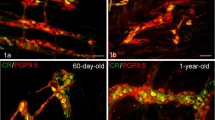Abstract
The distribution of calbindin D28k (CB)-like immunoreactivity (-LI) in the circumvallate papilla (CVP) was examined during development and regeneration following bilateral crush injury to the glossopharyngeal nerve in the rat. In the adult CVP, CB-like immunoreactive (-IR) nerve fibers were observed in the subgemmal region and some penetrated into the taste buds. CB-LI was also detected in the cytoplasm of the spindle-shaped gustatory cells in the lower half of the trench epithelium, which contained numerous synaptic vesicles and bundles of intermediate filaments. These CB-IR gustatory cells made synapse-like contacts with CB-IR nerve terminals. Some CB-IR nerve terminals made contacts with the gustatory cells negative for CB-LI. At least three developmental stages were defined with regard to the developmental changes in the distribution of CB-LI: (1) Stage I (embryonic day (E) 18–postnatal day (P)5): CB-IR nerve fibers appeared in the lamina propria just beneath the newly-formed CVP at E18, but the gustatory epithelium of the CVP contained no CB-IR structures. Taste buds with taste pores appeared at P1. (2) Stage II (P5–10): thin CB-IR nerve fibers began entering the trench epithelium, but no CB-IR cells were observed. (3) Stage III (P10–adult): in addition to the intragemmal and perigemmal CB-IR nerve fibers, very few CB-IR cells appeared in the taste buds around P10, and their numbers increased progressively. The changes in the distribution of taste buds and CB-LI following glossopharyngeal nerve injury were similar to those observed during development. On post-operative day (PO) 4, the taste buds and CB-IR cells decreased markedly in number. These CB-IR cells became round in shape, and the number of CB-IR nerve fibers decreased markedly. On PO8, both taste buds and CB-IR cells disappeared completely. The regenerated taste buds were first observed on PO12, increased rapidly in number by PO20, and increased slowly thereafter. CB-IR nerve fibers accumulated at the subgemmal region and began penetrating into the trench wall epithelium around PO16. CB-IR cells appeared between PO20 and PO24, and their numbers increased progressively and reached the normal level on PO40. The topographical localizations of the taste buds and CB-IR cells during development and regeneration were comparable to those of normal animals. The delay of the time courses for appearance of CB-IR nerve fibers and CB-IR cells compared to the appearance of taste buds during development and regeneration suggests that CB in the gustatory epithelium may participate in the survival of the taste bud cells rather than in the induction of the taste buds.
Similar content being viewed by others
Author information
Authors and Affiliations
Additional information
Received: 16 January 1997 / Accepted: 9 June 1997
Rights and permissions
About this article
Cite this article
Miyawaki, Y., Morisaki, I., Tabata, M. et al. Calbindin D28k-like immunoreactivity in the developing and regenerating circumvallate papilla of the rat. Cell Tissue Res 291, 81–90 (1997). https://doi.org/10.1007/s004410050981
Issue Date:
DOI: https://doi.org/10.1007/s004410050981



